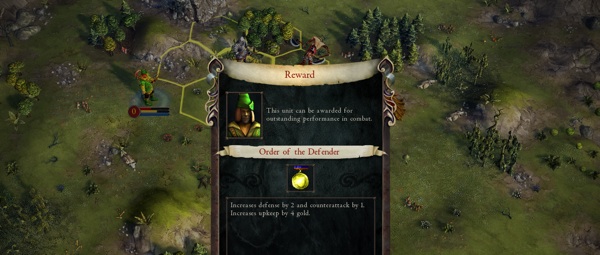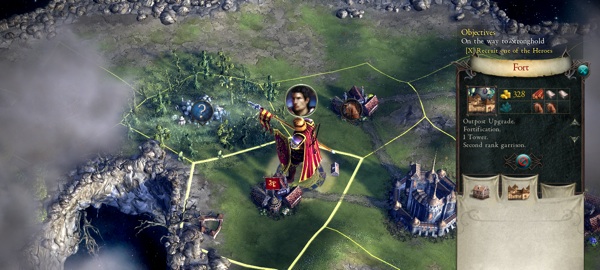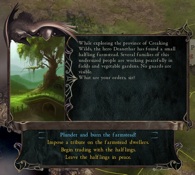Eador: Masters of the Broken World – PC Game Interview

ArmchairGeneral.com: Masters of the Broken World (MBW) seems to be one of the most tactics- and strategy-focused fantasy games in many years. Where did the inspiration come from? What other games, especially hardcore wargames, influenced MBW?
Vladimir Tortsov: MBW was envisioned as a mixture of different gameplay concepts from day one. On one hand, it’s the exemplary HoMM 3 (Heroes of Might & Magic 3) with its picturesque landscapes, castle building, heroes for hire of various classes, and tactical combat. On another, it reflects games like Sid Meier’s Civilization, or Total War, with their macrostrategic planning, diplomacy and skillful investments into economics.
{default}Naturally, it wouldn’t go anywhere without the influences of such classic hits as Master of Magic and Age of Wonders; MBW‘s basic premise of "a turn-based strategy set in a fantasy world" grows from there.
ACG: Can heroes be customized, with weapons, armor, and skills, and to what extent?
VT: Absolutely. There are four hero classes to choose, and that’s only the beginning. On level 10, a hero must specialize by picking one of the four second-tier classes. For example, a 10th- level Warrior may turn into Berserker, a fighter of great strength able to invoke battle rage or turn into a Dark Knight, taught to animate fallen combatants as undead and employ other necromantic stuff. (We do not condone those, of course. We’re claiming that anyone who played a necromancer in Diablo 2 has to be a closet fan of Lady Gaga or, uh, Cradle of Filth).

Class specializations and their unique abilities aside, you can further customize a hero with a particular set of spells and items. For example, a Wizard’s repertoire of magic may be of a healer nature, intended to support and encourage the troops, or a portable menagerie of monsters to summon. A Warrior may be geared for speedy and efficient slaughter, or to "tank" and withstand a lot of damage while tying the whole enemy army around himself.
ACG: Why was the decision made to make heroes purchasable, versus developing their skills up through the ranks?
VT: It’s not working that way actually. You can’t purchase a ready-made hero of a specific level in MBW; they all come at level 1. You still have to hire them for a hefty sum of gold and crystals, though. There are 4 different types of heroes in the game, each with his own strengths and weaknesses, and all of them can earn experience points in battles, progress through levels and get some new, exciting perks.
ACG: What are the technologies in the game? Do they also have karma attached to their use?
VT: MBW features no scientific research the way Total War or Civilization handled it. The role of scientific development is performed by the technologies for constructing new buildings, acquired as the player conquers new shards. As you choose your next target for attack on the Astral level, it makes sense to consider the list of the buildings which will become available for construction once the particular shard is occupied. Therefore, the progress of technology in Eador is only possible through the military exploits, which is a much more "heroic" way of doing things than getting the advances from funding some abstract "scientific research," wouldn’t you agree?
Karma and technology are not connected; both good and evil Masters can earn access to all the buildings in the game.

ACG: Does each race have its own technologies?
VT: It is important to note that MBW has no playable races other than humans, in the common sense of the word. The player may ally with any of the races populating a particular shard, thus gaining access to its warriors.
Instead of some abstract technologies, the racial features are reflected in specific combat skills. For example, goblins fight well in the swamps, orcs can damage enemy armor when attacking, and lizardmen warriors regenerate their wounds.
ACG: Is there a limit to the size of armies?
VT: The Master can only hire up to eight heroes per map. Moreover, while it is physically possible to have that many, in truth a player is highly unlikely to have more than four, as their cost increases exponentially. An army led by a hero of the commander class can consist of up to 16 units, hero included.
 ACG: Give examples of how the "good vs. evil" decision dilemma works on the tactical, strategic, and global levels.
ACG: Give examples of how the "good vs. evil" decision dilemma works on the tactical, strategic, and global levels.
VT: On the topmost, Astral level, the karma of our alter ego influences our diplomatic opportunities and the attitude of other Masters towards him. Would we support a necromancer Master in his ambition to destroy all life, or secure the assistance of a more humane ally? This is the kind of decisions to be made on this level. The game features 12 different endings and the player’s actions in the Astral strongly influence the final outcome of the game.
The effect of the karma is most obvious on the strategic layer. Some event or another happens pretty much every turn in the provinces we control, and the way we respond to them defines the changes of our character’s reputation. Did you refuse to assist the citizens of a province struck by a plague? Get ready for the survivors to rise up in insurrection several turns later. Invading an Orc province as an evil Master? You might actually expect a warm welcome—orcs hate those stupid elves and priests as much as you do.
On the tactical level, karma does not reveal itself directly. However, some of the player’s actions do affect it beneath the hood. If you rely too much on summoning demons and animating undead, your karma will plummet into the depths of evil, while using the spells of Light may save your karma yet … a bit.
ACG: Explain the alignment system used, and how it affects karma, and vice-versa.
VT: Each of the eight primary races of MBW has a specific alignment, be it neutral, evil or good. During the war over a shard, the Master’s armies clash with the local populace whenever they invade a province. Depending on whether the alignment of the population and the Master’s karma-defined reputation are in line, the annexation may proceed peacefully or end up in bloodshed.
Once the province is conquered, the population’s loyalty will largely depend on how close the alignments of the people and the ruler are, as well. The elves would be oppressed under the yoke of a tyrant, whereas the goblins would be annoyed by the ways a kind Master rules.
The alignment system affects the Master’s karma whenever he hires new units or casts combat spells. The goblin warriors are cheap for hire, but using them is bad for your karma, while casting a spell like Inspiration not only boosts the morale of a target unit, but makes the Master a better person too.
ACG: What are some perks and skills in game? Are they also affected by karma, and how?
VT: Special abilities are what make the heroes, as well as the rank and file units, unique. Let’s take the "Insensitivity to pain" ability some undead units possess, for example. While an elf or a gryphon suffers a penalty to his stats when wounded, a brutally maimed ghoul would keep fighting in earnest no matter his wounds.
To take another example, the basilisks are able to turn their opponents into stone statues. A petrified unit is unable to move or attack, but his defense is significantly increased—he is now made of stone, after all! After a while, a unit can shrug off the petrifying effect, but the battle may well be over by then.
There is no direct connection between karma and unit abilities; however, some abilities are only possessed by the warriors of Light, while others are typical for the servants of Darkness.

ACG: Is there room in game for a "neutral" faction, for the player who wants to use a balance of both good and evil units?
VT: It is possible to stay neutral; most events tend to have an outcome that is neither good nor evil. As a rule, most of the population couldn’t care less about the moral dilemmas you suffer. Except those pretentious elves that never seem to keep their mouths shut.
ACG: What happens when, for example, a good unit becomes part of an evil players’ army?
VT: It will suffer a penalty to morale, possibly making it less effective in a battle. It might run away as soon as the things start getting hot.
Worse yet, when there are evil units in the party as well—such as the orcs, thieves, imps and so on—their morale will suffer too, as they aren’t keen on fighting alongside their natural enemies at all.
ACG: What is the level of combat set at visually? Is it graphically brutal, do units just simply keel over when defeated, or somewhere in between?
VT: One can say it is somewhere in between. We don’t have any intentional blood and gore, but the deadly swings of axes, pikes, and claws may seem very brutal sometimes. Whenever a unit dies, a pile of bones remains on the battlefield. There is a reason for that—the deceased units may be resurrected or raised as walking corpses right on the battlefield.
ACG: What should players know about the music in game?
VT: The original soundtrack was created by composer Evgeniy Guljugin and it was partially remastered by Alexey Menschikov. The game OST will be available as a part of Collector’s Edition (TBC) and also as a separate downloadable bonus.
ACG: Will there be multiplayer? Map editor tools? Future downloadable content? Dragons?
VT: Multiplayer is definitely in, not in Astral mode though—that would make a quickest game last for many weeks.
An editor—most certainly. A game is only as good as its mods are. Look no further than the wonderful DOTA the fans made out of the boring Warcraft III.
There will be only one dragon; there are far too many of them in games already. (Just kidding about Warcraft III—it’s a great game.)
ACG: What gaming platforms are you looking to publish on?
VT: At the moment we are aiming for PC and Mac releases in Autumn 2012.


A very interesting proposal. I would be looking at multiplayer and I hope that a LAN multiplayer option is included for say up to 8 players. That would make this game an immediate’.buy’ proposal for me. Living in Malta an island good communications but low ping times playing on the internet is a distant second option.
Very much looking forward to this game!
Don’t forget to check the game’s site and Facebook if you’re looking for more info about Eador:
http://www.snowbirdgames.com/eador
http://www.facebook.com/MastersOfTheBrokenWorld